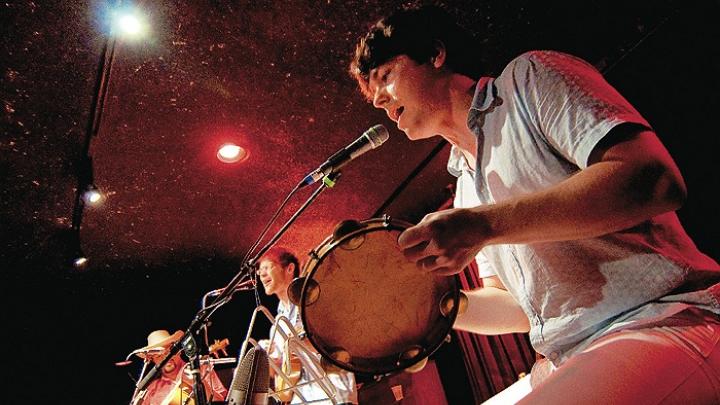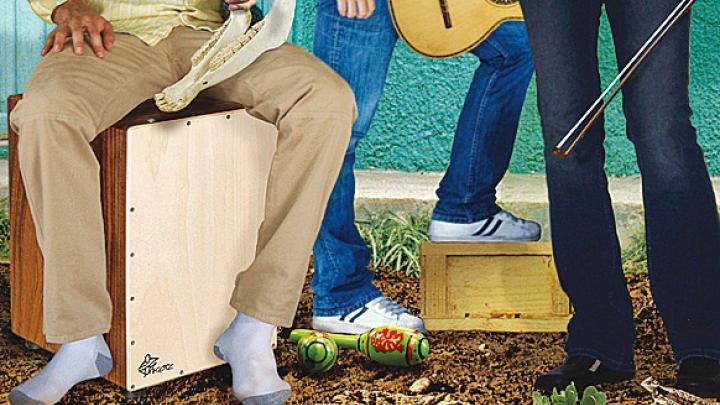David Wax ’06 never took a music course at Harvard. But while traveling and studying music in Mexico on a Sheldon Fellowship after graduation, he realized that what he really wanted to do was learn to perform the Mexican “roots” music he loved so much. Instead of pursuing the academic career he seemed destined for, the history and literature concentrator is now a professional musician, the founder of La Tuza, a Mexican roots-music trio that has been performing around New England for the last couple of years. La Tuza recently issued its first CD, Son del Otro Lado (“Sound from the Other Side,” available from www.latuzamusic.com).
Son—“sound”—is the collective word for Mexican folk and popular music. Música, Wax explains, was the word for the art music of courts and cathedrals; son “was the ‘noise’ everyone else made.” Son (rhymes with bone) exists in many styles and forms, most of them regional in origin, yet also reflecting the complicated cultural history of Mexico. Son therefore mingles indigenous music with Spanish, African, and Caribbean influences, not to mention polkas and waltzes that came to Mexico by way of German immigrants to Texas.
Wax focused on three kinds of son he felt he could learn. Son jarocho, which comes from Veracruz on the Gulf of Mexico, is probably the best known outside Mexico because of the international popularity of the 1958 Ritchie Valens hit “La Bamba,” an adaptation of a local folk song.
Son Huasteco, from northeastern Mexico, is music for dancing. “The meter never changes,” Wax says, “and when people hear it, their feet start moving into a huapango—there is no excuse not to dance.” The singing is tricky, because the melodies lie high and require acrobatic leaps into falsetto. The fiddle-driven son calentano, from southern Mexico’s Tierra Caliente, also requires dancing but of a more sophisticated kind, because the interlocking rhythms are more complex; a pair of dancers usually performs a foot-clicking zapateado on a platform alongside the musicians. Though the names of many son composers are lost, Wax says that some key creators of son calentano are famous in Mexico.
Part of La Tuza’s mission is to demonstrate that there is a lot more to Mexican music than the familiar strains of mariachi bands. He admits he is no ethnomusicologist, but explains that the popularity of mariachi derives from the golden age of Mexican cowboy movies in the 1940s; it’s an urban descendant of son calentano that reflects nostalgia for a rural life. “In the 1930s, cornets and then trumpets were added to the violins in mariachi music,” Wax says, “because they made the music sound better on the radio.”
Traditional son ensembles usually include a violin; guitars of various sizes, timbres, and tunings; and percussion instruments—yes, that strange sound you hear in son jarocho is the clattering teeth in the jawbone of an ass, the quijada. The lyrics, sometimes traditional, sometimes improvised on traditional texts, range widely. Many are about love, of course, sometimes filled with bawdy innuendo, sometimes expressed as fables about personified animals. But there are also songs of battles and heroes, and others reflecting the conditions of daily rural life.
Assimilating different styles of Mexican music comes naturally to the soft-spoken Wax, who for most of his life has engaged with many kinds of music. Growing up in Columbia, Missouri, he learned classical piano but soon shifted to jazz; he also played in a klezmer ensemble. (In La Tuza he sings and plays guitar and its Mexican cousin, the jarana.) In high school, he was the drum major in the school’s marching band, played in a rock band, and played the electric bass in church. Wax has also written songs from an early age. (Besides La Tuza, he’s created another group, The David Wax Museum, to perform his own songs. One is an adaptation of a Mexican song in La Tuza’s repertory, though it sounds quite different because he added folk, country, and bluegrass to the mix, along with a saxophone, which evokes the world of jazz.) He says poetry classes at Harvard helped hone his skills as a lyricist, and his concentration in Latin American history and literature helped him understand the roots of roots music.
Wax transferred to Harvard after two years at Deep Springs, a tiny, all-male experimental college on a ranch in California. He first went to Mexico in the summer between his two Deep Springs years. “I was mesmerized by son even then,” he recalls. “Because I was doing rural development work in a very small town, I could see very clearly the role music plays in bringing people together. They would get together for a fandango, their version of a hootenanny, and play music all night.”
Wax says he hasn’t encountered much resistance to the idea of an American crossing the border to perform Mexican music. “Some people in this country dehumanize Mexicans because of immigration issues,” he says. “But there is a rich culture in Mexico, and this beautiful music deserves to find a wider audience. Perhaps it can help people to think about Mexico in a different light. Most of the musicians I encountered in Mexico were thrilled that someone else was trying to learn their music. Nobody cared that I am a gringo.”










